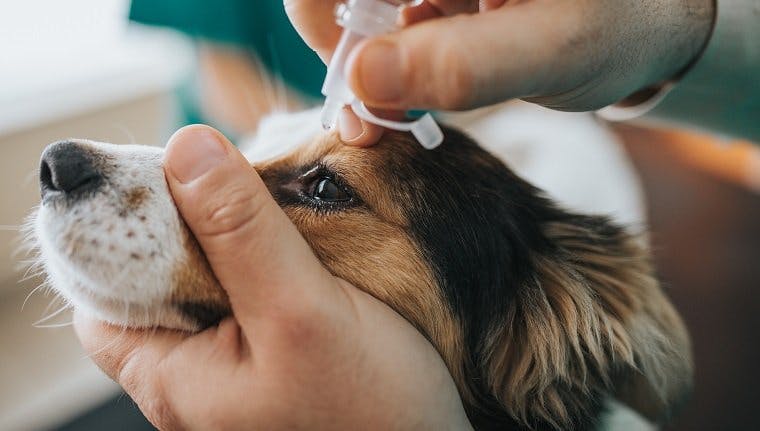If you think dry, itchy eyes are bad for us, imagine how your pet feels. Discharge from your pet’s eyes may be an indicator that something is wrong, but problems like dry eye might be easy for pet parents to miss. Artificial tears are a common staple in our medicine cabinets for our human family, but what about artificial tears for pets?

Usage and Dosage
Artificial tears come in two forms: drops and ointment. They’re used to temporarily increase moisture and lubrication in the eyes and ease discomfort. Artificial tear drops can sometimes treat inflammation issues too. Though artificial tears are readily available over the counter or online and are safe in most cases, it’s still imperative to contact a vet to make sure you pick the best option for your cat or dog before you apply anything to your pet’s eye.
Based on your description of your pet’s condition, your veterinarian may recommend holding off on any drops or ointments until their condition can be evaluated more fully. If your vet gives you the “OK”, here are a few tips to follow when you’re giving artificial tears to your pet:
- Read the directions on the box carefully and follow up with your vet if you have any questions.
- Wash your hands thoroughly.
- Keep your dog or cat calm and gently spread their eyelids. Administer the drops or ointment according to the instructions on the box or from your vet. Avoid touching your pet’s eyes with the container. Repeat the dosage in the other eye.
- Store the artificial tears at room temperature and away from moisture and sunlight.
- Wait at least 5 minutes after applying artificial tears before you apply any other medications to your pet’s eyes.
- Wash your hands again.
A common use for artificial tears is as a supplementary treatment for a condition called “dry eye syndrome” (keratoconjunctivitis sicca, or KCS), which results from a lack of tear production. Common causes for dry eye syndrome include:
- Congenital disorders
- Medications
- Infections
Dry eye syndrome is quite common in certain dog breeds, like bulldogs, cocker spaniels, Shih Tzus, west highland white terriers, Lhasa Apsos, and schnauzers. If you have one of these breeds, monitor closely for signs of KCS like inflamed whites of the eyes, thick discharge and crusting around the eyes, or squinting and general discomfort.
Unlike other mild ocular conditions, KCS requires timely diagnosis and prescription eye treatments to avoid serious complications — artificial tears may be a component of treatment, but are inadequate to treat this condition alone. If you suspect your dog could be suffering from this disease, contact your veterinarian for a full assessment.
Side Effects
Artificial tears are generally safe, but side effects like discharge or itchiness are still a possibility.
Be sure to monitor your pet’s eyes for these signs of an allergic reaction:
- Hives
- Swelling
- Difficulty breathing
If your dog or cat experiences any of these symptoms after taking a medication or treatment, contact a veterinarian immediately.
Now that you know more about artificial tears, including how to administer them, and when to contact your vet, here are some tips on how to maintain good eye health for your fur babies:
- Perform weekly eye checks: Get used to looking at your pet’s eyes very closely so you know what’s normal. Make sure the whites of their eyes are not red or bloodshot. Be sure to check for discharge and cloudiness too.
- Keep their eyes clear of mucus: When they wake up in the morning, pets can often have “sleep” in their eyes just like we do. To remove the mucus, you can use an eyewash or artificial tears to flush their eyes, then use a soft cloth to wipe up the excess liquid. If there is excess crusting in the fur near the inside corner of your pet’s eye, you can also try wetting the crusts with an artificial tear solution and using a fine-toothed comb (like a flea comb) to gently pull the crusting away from the skin. This keeps the area cleansed and decreases the likelihood of uncomfortable skin inflammation.
- Keep fur trimmed away from the eyes: When fur around the eyes is trimmed, it’s much easier to get a good look at your pet’s eyes. Longer hair will accumulate more irritants than shorter hair. Also, long hair can irritate your pet’s eyes by touching them or rubbing against them. You can use an at-home tool like The FURminator or take your pet to a professional groomer. Please do not try to use sharp scissors around your pet’s eyes. Pets can move suddenly and quickly, commonly resulting in lacerations on the face or serious lesions to the eye itself.
Helping your pet maintain healthy eyes is a snap now that you know what to do. Remember to connect with a licensed veterinarian before administering any treatments, even if you’re buying something over the counter.






